A live journal of blessed activities in and around Kanha with Daaji
Simple tips to avoid making mistakes by Daaji
Archive
Last 5 entries
Noida, Uttar Pradesh, 13th and 14th June 2025
The significant highlights of Daaji’s travels in Delhi and Uttar Pradesh were the inauguration of the Bharatiya Gyan Parampara Kendra (Centre of Indian Knowledge Systems—CIKS) at Galgotias University situated in Greater Noida and his visit to Noida Ashram.
Q: How can Heartfulness app help us become mindful, emotionally resilient and socially attentive leaders in this modern world?
Daaji: All three aspects of life you mentioned are to do with your awareness. When Lord Krishna says in the Bhagvad Gita, “yoga karmashu kaushalam,” i.e. if you take meditation seriously and attain a state of yoga, all your activities in that state of mind will attain perfection. Meditation and cleaning are the means, it is up to you how to use them.
13 June
A significant highlight of Daaji’s travels in Delhi and Uttar Pradesh was the inauguration of the Bharatiya Gyan Parampara Kendra (Centre of Indian Knowledge Systems—CIKS) at Galgotias University situated in Greater Noida. CIKS is envisioned to blend India’s ancient knowledge systems and spiritual wisdom with contemporary science, innovation, and AI. In alignment with the Ministry of Education’s vision of embedding India’s intellectual heritage into higher education, this initiative marked a thoughtful step toward preserving tradition while preparing institutions for the future.
Daaji’s arrival at the university was met with ceremonial fanfare. NCC cadets lined a red carpet, standing in formation. The university’s chairman, his son, and the family received him warmly. The welcome was formal, yet personal.
The first stop was the inauguration of the Heartfulness Lounge—the first of its kind within a university in India. The lounge was designed as a dedicated space for students to learn and practice Heartfulness meditation. Fully air-conditioned and thoughtfully furnished, it featured instructional videos, a curated selection of Heartfulness literature, and weekly sessions led by certified trainers. Daaji offered prasad and formally opened the space.
On stage, Daaji was felicitated by the university’s Chancellor, Shri Sunil Galgotia, and the CEO, Dr. Dhruv Galgotia, before the unveiling of the CIKS plaque. Soon after, a Memorandum of Understanding (MoU) was signed between Heartfulness and Galgotias University, laying the foundation for collaborative research, educational programs, and outreach initiatives.
In his inaugural address, Daaji highlighted how the essence of Indian knowledge lies not just in preservation but in integration—reviving the wisdom of the Vedas, Upanishads, and spiritual sciences while making them relevant to today’s students. He urged the younger generation to carry forward this legacy with scientific curiosity and experiential practice, particularly through meditation. His reflections beautifully emphasized that true knowledge must not remain confined to books but should transform minds, hearts, and ways of living—an echo of the very aim behind the new centre.
Following the meditation session led by Daaji, a lively and engaging Q&A unfolded. Here are a few excerpts from it.
Q: My peers mock me, saying meditation is doing you no good, one can’t really focus during it, and tranquillity isn’t a real thing. I really want my loved ones to feel the peace I feel during meditation. How can I make them understand this?
Daaji: Welcome to the world of struggles in life! If you try to convince others, it will always fail. Practice yourself; it’s for yourself. And once they start seeing change in you, the trajectory of your life, then they will be awed. My college mates in LM College of Pharmacy, Ahmedabad, also made fun of me back in 1976 when I started meditating, but soon enough, when my professors began to notice the change in us (a group of 25 who were meditating in college), they began to meditate—including my dean, who is now 99 years old. If one compares the students back then who weren’t meditating, and their families now versus the students who were meditating and their families now, you will notice a big difference.
I recommend you read a book The Biology of Belief by Dr Bruce Lipton which teaches how our lifestyle impacts our inner environment, our genetic manifestations, and how life changes simply by thought. It is our ancient wisdom packaged in a new style!
For example, Dr Lipton researched how the external environment changes the genetic manifestation of the embryo while in the mother’s womb. He noted that when an expectant mother lives under constant stress, her sympathetic nervous system activates, diverting blood from the abdomen, lungs, and brain to the limbs. The fetus experiences the same effect, leading to poor brain and digestive development. With reduced blood flow to the frontal cortex, thinking weakens while the primitive brain dominates, making the child reactive and prone to ADHD. In Indian tradition, pregnant women were often sent to their parents’ homes to stay happy and relaxed. This kept the parasympathetic system active, leading to calmer and more intelligent children.
Q: How can Heartfulness app help us become mindful, emotionally resilient and socially attentive leaders in this modern world?
Daaji: All three aspects of life you mentioned are to do with your awareness. When Lord Krishna says in the Bhagvad Gita, “yoga karmashu kaushalam,” i.e. if you take meditation seriously and attain a state of yoga, all your activities in that state of mind will attain perfection. Meditation and cleaning are the means, it is up to you how to use them.
Q: Some scriptures highlight desires as good, some do the opposite. How do you align western philosophies of existentialism, nihilism with Indian philosophies?
Daaji: Everyone says ‘don’t have desires.’ But how would you proceed in life then? If you wish to eat, you go to the canteen and eat. When you go home, and your mother has cooked something but you say you only want pizza, then something is wrong. Passion, which leads to desires, cannot ever be destroyed. You cannot have compassion without passion. Love, hate, likes, dislikes—all carry energy, and energy cannot be destroyed, only transformed. If a desire arises in the heart, what to do with it?—transform it, and make it better. So desires are not wrong; what matters is how and for what we use them. Similarly, the mind is not bad—we have to just train the mind, and the only mental gym we have is meditation. Ego too is not always negative. If it pushes you to improve, it is helpful; but if it makes you feel superior to others, it becomes arrogance. Ultimately, it depends on how we use our desires, mind, and ego—it’s about perspective.
After the talk, Daaji joined the chairman’s family and a few visiting professors from Singapore for a private lunch. Later in the afternoon, Daaji traveled to the home of a long-time preceptor and abhyasi family in Noida. Later, though the schedule was originally set aside for writing and recovery, Daaji decided to visit the Noida Ashram, where a large group of abhyasis had gathered in the meditation hall. Daaji conducted a brief session there and spent time with the abhyasis before returning home.
Dinner was followed by a few short meetings with dignitaries who had come to consult on upcoming projects. The day closed late, but on a note of progress—calm, deliberate, and forward-looking.
14 June
The morning began quietly. After some light refreshments, Daaji decided to head early to the meditation hall at the Noida Ashram. By the time he arrived, several hundred abhyasis (practitioners) were already seated, waiting in silence. He conducted meditation without delay. A short interaction with the abhyasis followed.
Here are some excerpts:
Q: Of late, I do not feel very connected to the Master. Earlier, there used to be a pull towards him, but now I do not feel it, and it worries me why I do not feel this closeness or nearness anymore?
Daaji: (smiling) That is your problem! There are many obstacles that come on the way in the form of tests. You have to find your own solutions to surmount certain problems, and that is where the success lies. Think of a metaphor—what would happen if you don’t let the butterfly struggle to break out of its cocoon, or the bird hatch out its egg by itself, or if you forcefully open a flower bud before it blooms on its own? Similarly, don’t let any master forcefully open it for you—you have to allow your inner flower [to bloom] with the warmth of your love and devotion: that is your business.
Q: Daaji, you have taken Heartfulness to such great heights with so much efficiency. Is it possible for an abhyasi, at a human level, to become like you?
Daaji: This work can never be done without abhyasis. I believe Babuji Maharaj was unfortunate—he, as such a great personality was there, but you all were not there.
So, without abhyasis, even the Masters cannot do anything. Even Lord Krishna, Lalaji Maharaj, and Swami Vivekanand would say that it is indeed very sad that in spite of there being so much power in him [Babuji Maharaj], people do not recognize him and benefit from his being there. So, you see, those who could spread his message are here, but were not there back then. So the credit goes to all our sisters and brothers. (…) Our job is to keep working for the mission, not for rewards: just keep working, that itself is the reward.
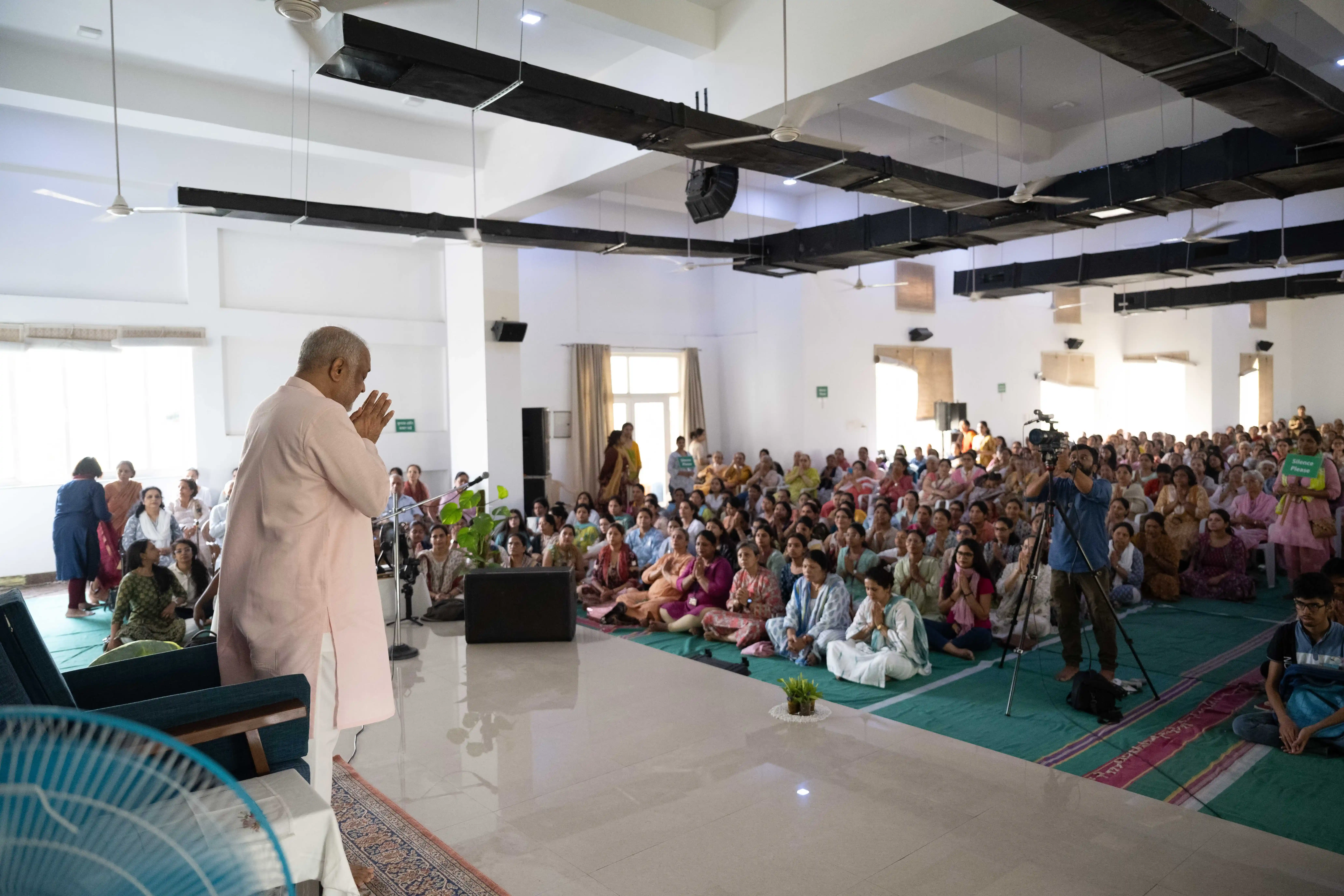
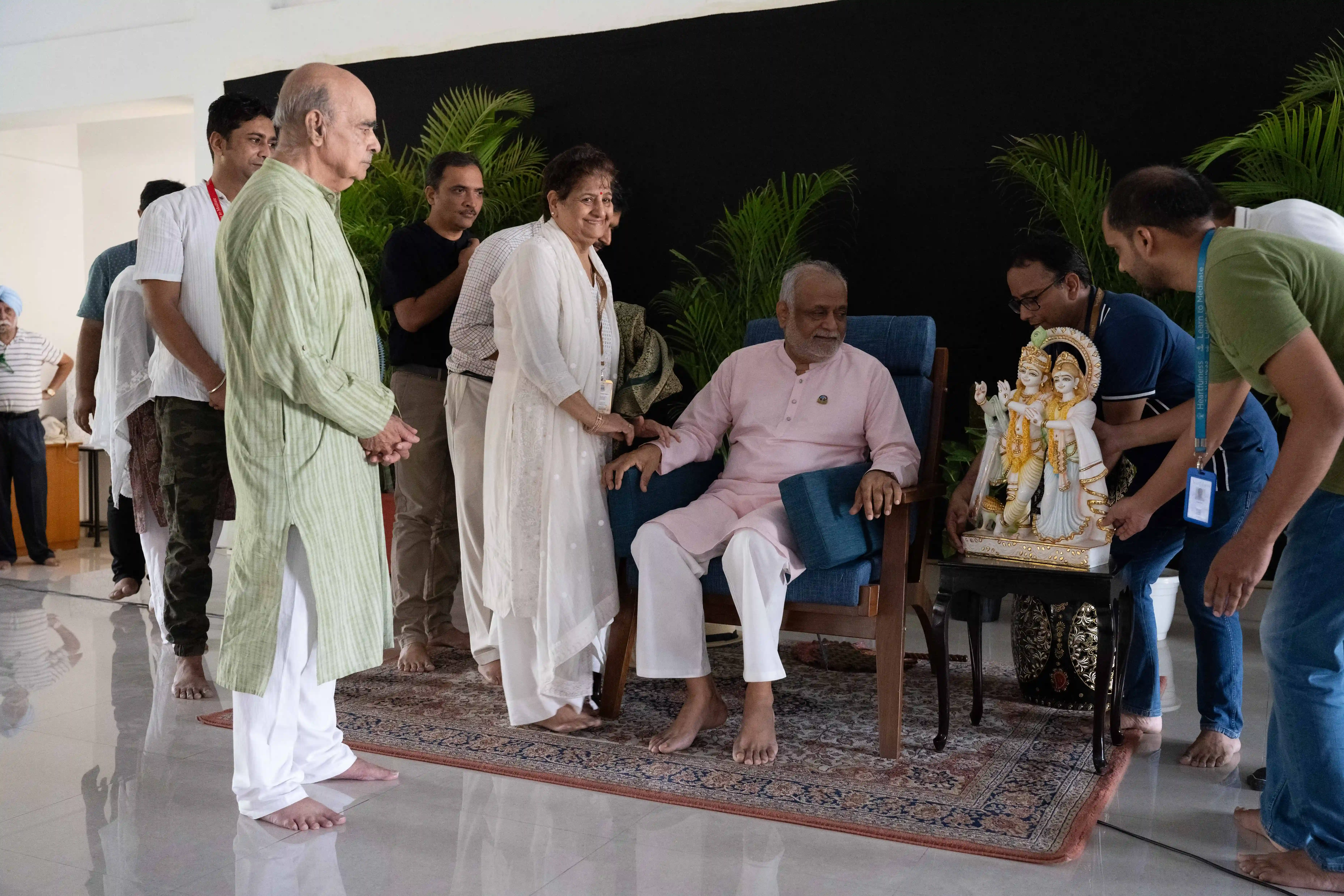
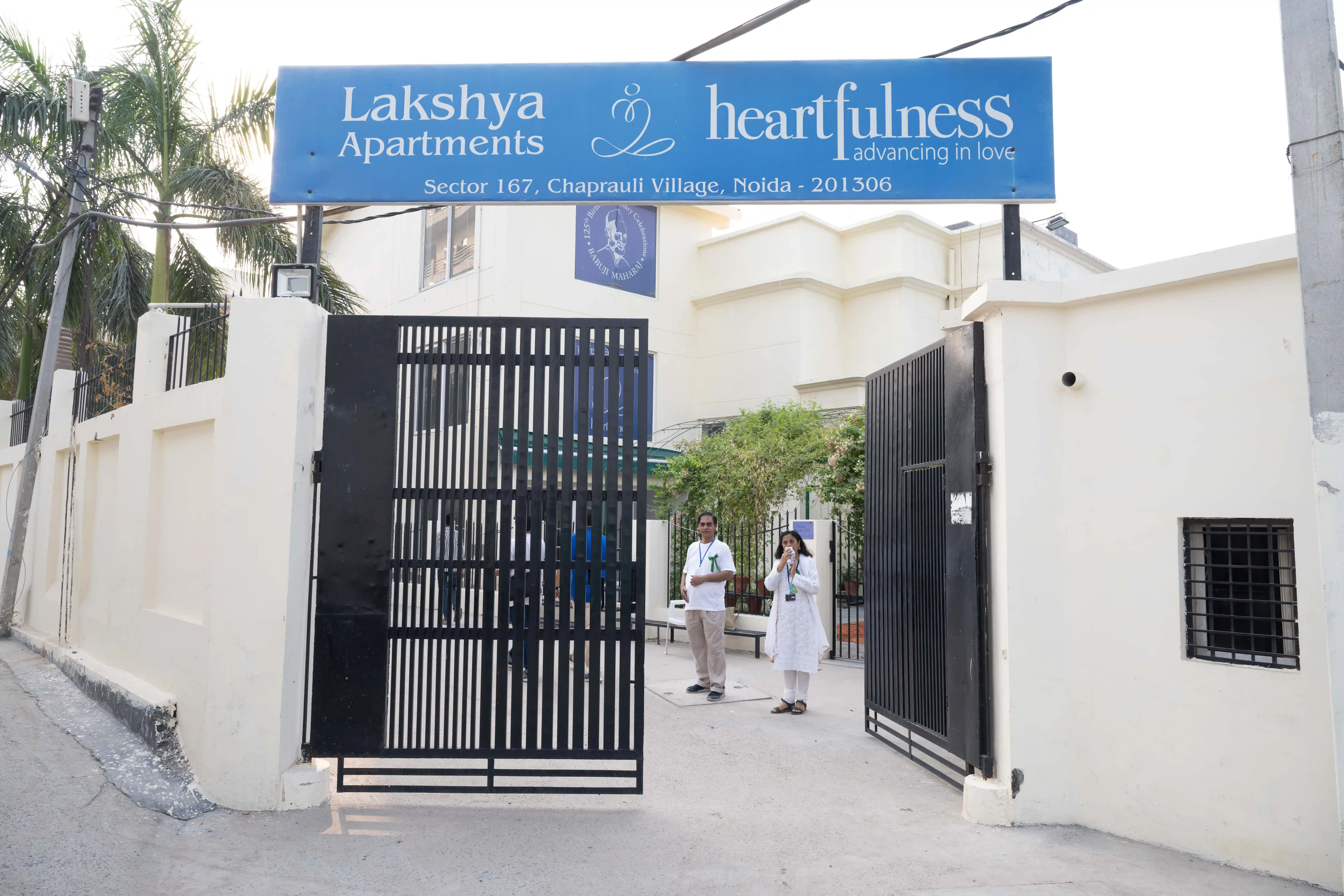
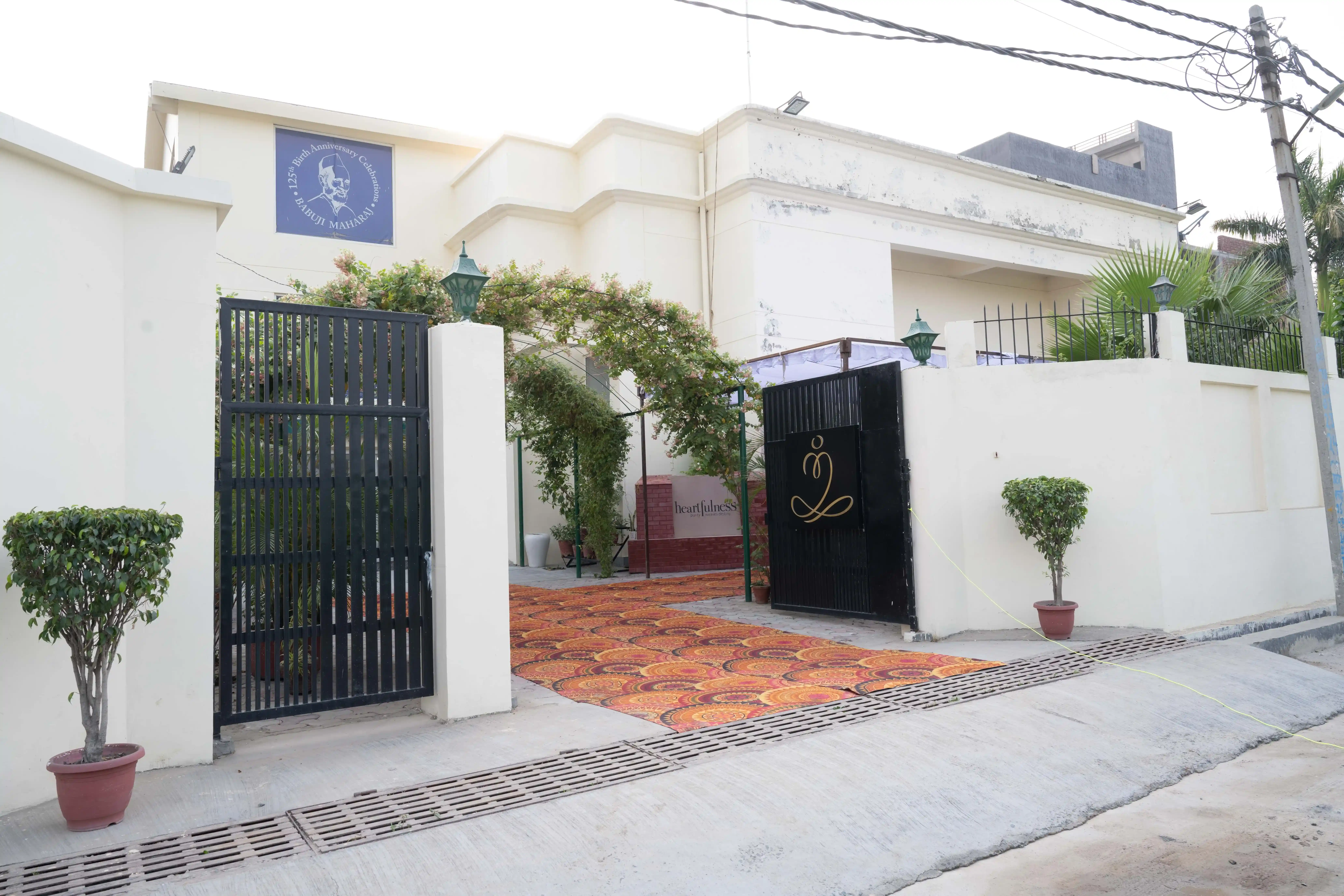
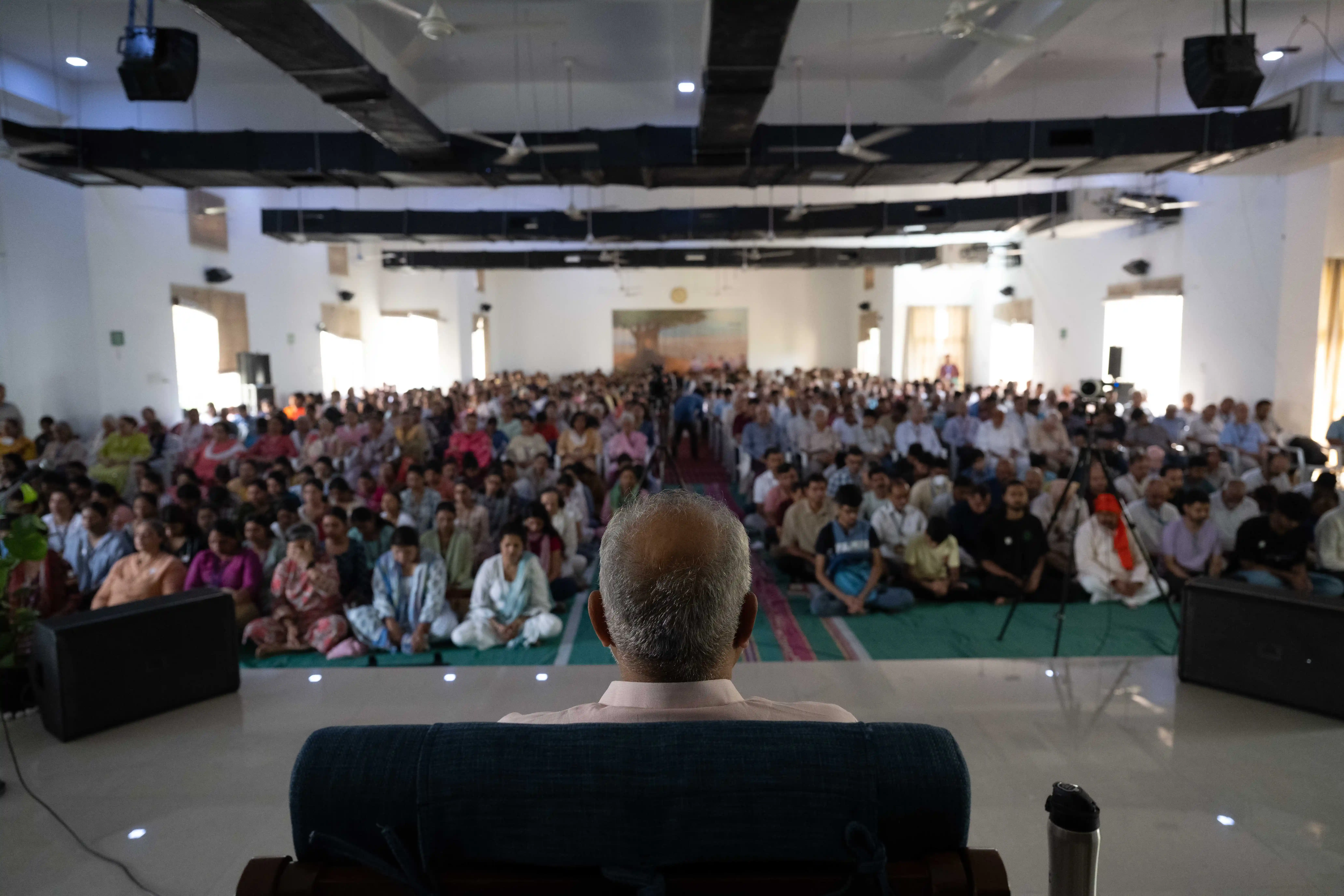
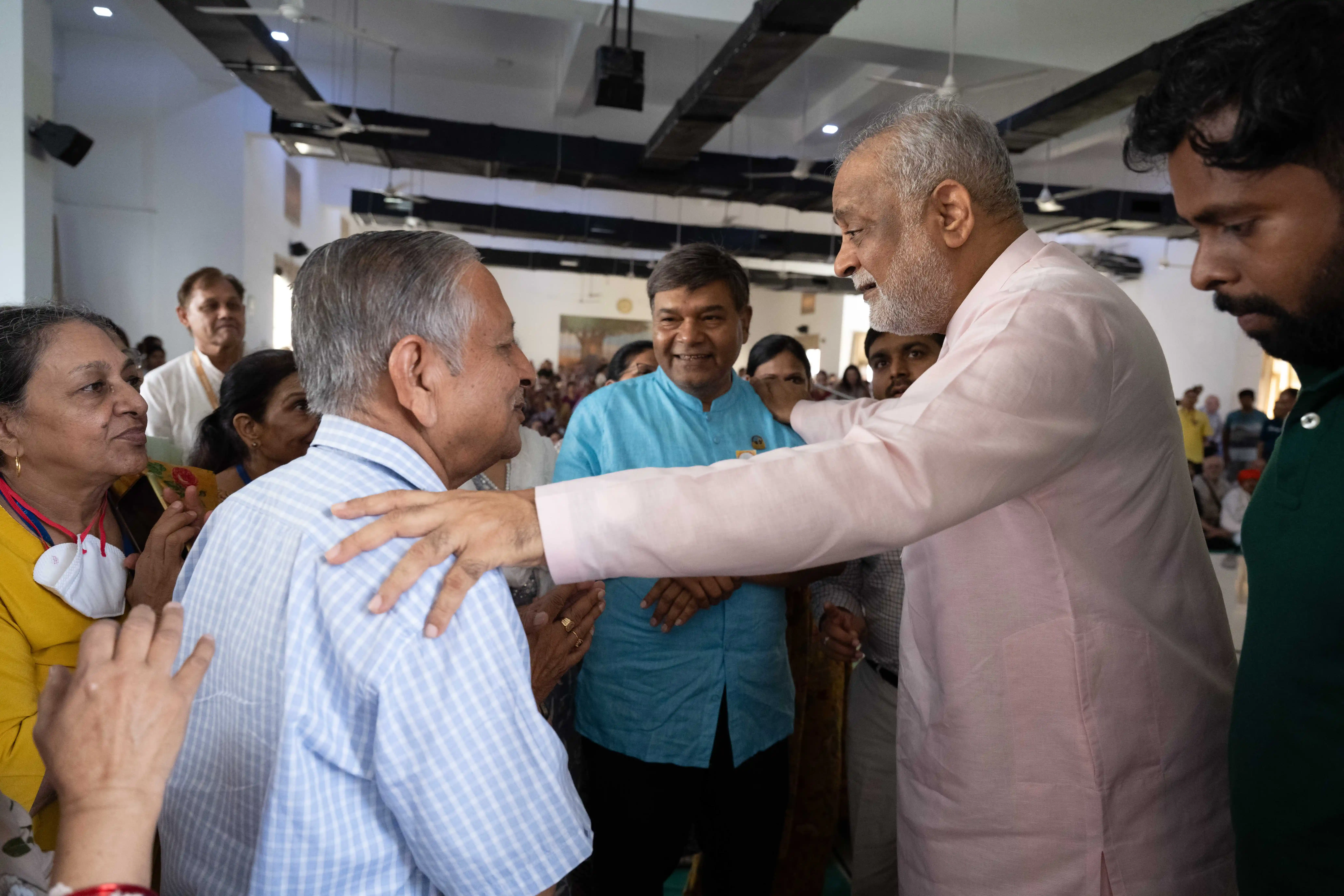
After the session, Daaji left the ashram to visit a nearby apartment complex where many of the Noida abhyasis reside. Over the years, this residential cluster had become a close-knit spiritual community, with nearly every flat occupied by practitioners. One apartment had been prepared for Daaji’s visit. He was welcomed warmly by the abhyasi sisters who had prepared a home-cooked breakfast. Over the meal, the conversation moved across a range of topics—personal, spiritual, and practical. Soon, more abhyasis came in, one by one, hoping for a few moments with Daaji. He listened patiently, offered guidance where needed, and made time for as many as he could.
Before beginning this journey, Daaji had mentioned something simple and clear: “On this trip, I want to meet abhyasis, as many as possible. This time is for them—to listen, to meditate together, and to simply be present with one another.” That’s exactly how the day unfolded.
From there, Daaji left for an interview for the Speaking Tree (Times of India Group), a special section (both in print and online), which is dedicated to spirituality, philosophy, and self-development. On YouTube, this interview was one of their “Connect with Antaha-Karan” [Connect with Inner Instrument] series.
The Speaking tree team was eagerly waiting to meet Daaji. They had a very interesting interaction right before the interview began. One of the team members mentioned that she had a meditative practice.
Daaji asked her, “How do you meditate?”
She replied, “With Shiv mantra, Devi mantras, visualization, guided meditation; I am a Shiv bhakt (devotee).”
Daaji continued, “So, let’s talk a little bit: what is meditation?”
She answered, “Anything that has your concentration is meditation, according to me.”
Daaji questioned again, “What is its Sanskrit word?”
She said, “Dhyaan.”
Daaji elaborated, “How do you split this word?
After a short pause, Daaji continued, “Dhy + yaan. Dhy [pronounced as ‘dhee’] is repeated twice in the Gayatri mantra. What is this ‘dhy?’ Divine wisdom, Ultimate wisdom. Yaan means vehicle. So the vehicle which transports you to divine wisdom is dhyaan (meditation). When we chant, the mind is busy, it is occupied; it cannot be transported. A busy mind can never be transported, whether you are meditating on Krishna or Shiva or your boyfriend. So in order to transport the mind, we have to use this vehicle, and you also need to fuel this vehicle. So how do you fuel this vehicle? Any vehicle needs to be fueled, right? So here, the fuel for transporting the consciousness has to be subtler than what you are propelling. Whatever fuel needs to push the consciousness has to be subtler than the consciousness, or else it will be a shock. Anything that sustains us has to be subtler than what you want to sustain. For example, if you want to go to sleep. So what is more refined, subtler than the consciousness? It is the subtle energy we call ‘prana.’ Prana is what supports our consciousness. In the Kena Upanishad, the sage says that all the koshas need nourishment; so what can support your soul?”
She replied, “Soul food.”
Daaji explained, “And what is that soul food? It is called ‘pranasya prana’ and that is the invention of Heartfulness where the Guru, with his grace transmits this pranasya prana or pranahuti [yogic transmission], and that works as the fuel for the vehicle to transport your consciousness. And your awareness suddenly shifts as if from the third gear to the fifth.”
Another team member posed a question to Daaji: So, for receiving this pranahuti, is ‘patrata’ (eligibility, worthiness) necessary?
Daaji replied, “Not necessary: if it was, you would never evolve.’
She asked again, “But nowadays, why do gurus insist on it, that if you are not worthy, then the ‘shaktipata’ (energy transfer from guru to disciple) will not happen?”
Daaji’s reply was crystal clear. Even before she finished her question, he replied, “To escape the responsibility. You see, to escape this responsibility you can blame anyone at any time—‘you don’t deserve it’ or ‘you didn’t do what I told you to do’ or ‘you didn’t follow the protocol.’ It makes you feel guilty and with this guilt and heaviness, you can never progress. A Guru’s job should be to not to add to what is already existing in the form of heaviness.
She asked, “What is pranahuti [yogic transmission] like?”
Daaji smiled and said, “Experience it. Shall we begin meditation?
Daaji then led the meditation for them, and a short discussion later, the interview began.
It was one of the most amazing interviews where Daaji talked about his life experiences, whilst shedding light on many spiritual concepts. Daaji was very happy with the way the interview happened. Daaji asked all the team to come to Kanha so that more interviews could be planned.
In the late evening, Daaji left for Mathura by road—a two-hour drive from Noida. The destination was significant: the ashram located near Krishna Janmabhoomi, [the birthplace of Lord Krishna].
Stay tuned for more events from Daaji’s travels in Mathura and Iglas.